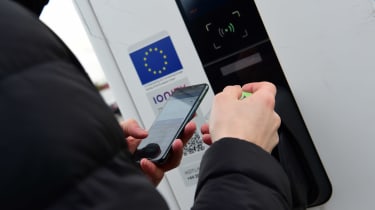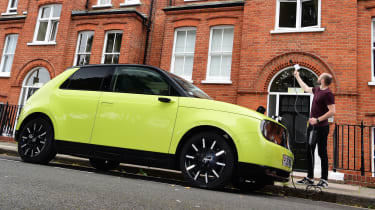Second report: cold weather proved to be a testing time for our electric Honda e supermini
4.0 out of 5
Buy used for less at Buyacar
Verdict
The Honda e is a cracking little electric car that’s capable of big motorway miles. But when the cold weather sets in, owners must be prepared to make some compromises.
- Mileage: 2,860
- Economy: 3.2 miles per kWh
Best electric cars to buy 2021
- Honda e vs MINI Electric
- Honda e review
- New Honda e 2020 review
- New Honda e 2019 prototype review
- Mileage: 2,260
- Economy: 3.6 miles per kWh
Life with the little Honda e, given the rather trying circumstances we’re all living through at the moment, is a genuinely uplifting experience. It’s a car that puzzles, delights and shocks people every day; some laugh, some point and some try to grab a picture with their smartphone. Wherever it goes, its presence provokes a reaction I’ve not had with any other car in the eight years that I’ve worked at Auto Express.
But behind the cutesy looks and pop-out door handles is a car that does require some sacrifice to live with – although day to day, in and around West London where I live, the Honda is a breeze to run. There’s a public charger 30 seconds from my flat, where it can be charged overnight for about £10, and its dinky dimensions and hilariously small turning circle make parking and battling London traffic fun. Almost…
Outside of London, however, things do get a little tricky. Last summer, not long after I collected the car, I had to make a 550-mile trip from Milton Keynes, Bucks, up to Newcastle and then back down to London. Knowing that the Honda was going to spend the majority of its time within the confines of the M25 the rest of the time, I thought it would be an interesting – and anxiety-inducing – test to see how the Honda fared.
More reviews
Car group tests
In-depth reviews
Road tests
With a bit of planning and plenty of patience, the journey was not as painful as I had imagined. The first 240-mile leg, for example, involved five and a half hours of driving and just over an hour and a half of charging to get to the North East. It was cheap, too, costing me only £15.18 in electricity, and getting around 120 miles out of a charge was much better than I had expected on the motorway. On average, I was seeing around four miles per kWh.
One thing I did have to adapt was my driving style. It seems there is a sweet spot, at around 60mph, where you can maximise the Honda’s range. Any quicker and there’s a noticeable drop off in terms of economy, so sharing the inside lane with HGVs and other thrifty EV owners is something I had to get used to. But the Honda is a great cruiser with superb refinement and a brilliant ride quality for such a small car.
In fact, the Honda almost did much of the driving for me, because the trip gave me the opportunity to use the car’s decent adaptive cruise control and lane-keep assist systems. Again, finding this sort of kit on a car this small is quite rare. But then again, the Honda is far from cheap.
Fast forward several months to the winter, and life with the Honda becomes a very different ball game. During the warmer months, getting 120 miles on a full charge was little effort, but once the temperature drops to single figures, the range falls to around 80 miles – that’s quite some difference and requires another level of planning if you intend to make longer journeys.
No matter how carefully you drive, or how good you are at leaning on the regenerative braking and reading the traffic ahead, winter is not the electric car’s friend. I even inflated the tyres to 40psi to see if that would make any difference, but it didn’t. However, this isn’t a problem specific to the Honda, because most other electric cars suffer from the same ‘phantom’ range during the winter months.
I’ve also found that the estimated range from the Honda’s trip computer is quite the pessimist. On a cold day with a full battery, the readout has often said that only 60 miles will be possible, when in reality I’ve driven closer to 80. Having said that, if the readout was being optimistic it would be a far greater issue.
With warmer weather on the way I’m hoping that the Honda will begin to travel a bit further with every recharge, because the more I drive it, the more I like it. I just wonder if my patience with the range would have worn thin by now if the rest of the car weren’t so impressive.
Honda e: first report
A lack of home charging hasn't spoilt our time with our new Honda e
One of the latest arrivals on the Auto Express fleet, the funky new Honda e, has been helping me to answer one very simple question: can you live with an electric car without being able to charge at home?
As with many people who these sorts of urban EVs are aimed at, I live in a flat without any option of charging at home. With a huge proportion of drivers living in urban areas and electric car sales growing, this is going to be a theme that becomes increasingly common. How exactly are people expected to live with them? A reliance on the public charging network is the only realistic option, so you can consider me a guinea pig.
This obvious compromise that I’d have to make when running an EV is the one thing that has stopped me from making the switch sooner. So it was going to take something pretty special to come along and change my mind. But the Honda e is just that; not only is it a cool and original approach to an electric car, crucially, it’s also very desirable. Few other EVs manage to achieve that.
Of course, the design won’t be to all tastes. Some people laugh, others stare and some genuinely have no idea what it is and want to chat about it. Very few cars attract attention in the same way as the Honda e –and no doubt the Charge Yellow finish of our car has something to do with it.
The version we have on our fleet is a top-spec Honda e Advance. Inclusive of the Government’s £3,000 grant for zero-emission plug-in cars, the Honda e will set you back £29,660. On a 36-month PCP deal, that works out at £311 per month if you can stump up a £6,500 deposit. Whichever way you look at it, this is a small electric car with a big price tag.
What do you get for that? Well, quite a bit, actually. As standard this Advance model comes with a 35.5kWh battery that feeds a more powerful 152bhp rear- mounted electric motor for a claimed range of 137 miles. Inside, there’s the full-width infotainment set-up with digital wing mirrors and rear-view mirror, heated seats and steering wheel, wireless Apple CarPlay, a sunroof, parking sensors and a rear camera. Oh, and the cool pop-out door handles.
There isn’t a single option fitted to our car, either. Charge Yellow is the only paint colour that’s standard; black, blue, white and grey are all £550, which seems a little odd. You can add leather, but the standard seats are finished in a soft-yet-textured fabric that looks great and is comfortable.
So the obvious question is how much of a headache is charging it? In short, it’s not been an issue. Over the past month or so, I’d usually charge it up once a week at the Source London point at the end of my street. With around 15 per cent left in the battery, a full top-up takes roughly four hours from a 7kW unit, which costs around £9. I’ve been averaging upwards of 100 miles on a full charge, which is 30 miles short of the official range, but I’ve had 120 miles out of it on a longer motorway drive. However, living and driving around central London – the Honda’s natural environment – 100 miles seems to be the average return so far.
And for battling traffic, squeezing through width restrictors and nipping into gaps, the Honda is proving to be the perfect runaround. Of course, outside of its comfort zone it could well be a different story. And a 270-mile trip north up the M1 awaits.
| Model: | Honda e Advance |
| On fleet since | August 2020 |
| Price new: | £29,660 |
| Powertrain: | 35.5kWh battery, single electric motor, 152bhp |
| CO2/tax | 0g/km/£0 |
| Options: | None |
| Insurance*: | £534 |
| Mileage: | 2,860 |
| Economy: | 3.2 miles per kWh |
| Any problems? | None so far |
*Insurance quote from AA (0800 107 0680) for a 42-year-old in Banbury, Oxon, with three points.
Next Steps
Source: Read Full Article



 Best electric cars to buy 2021
Best electric cars to buy 2021

